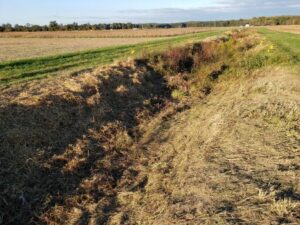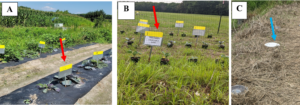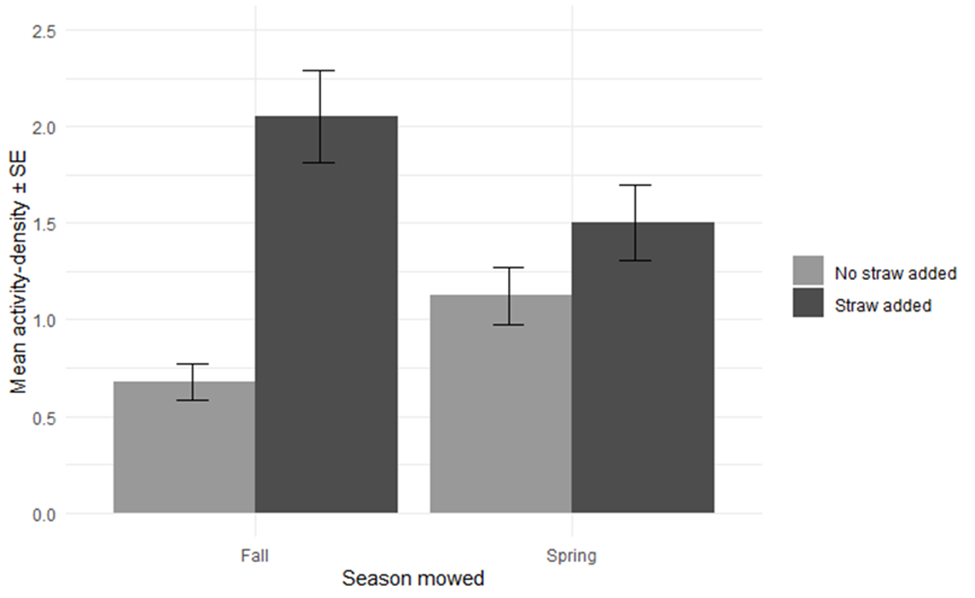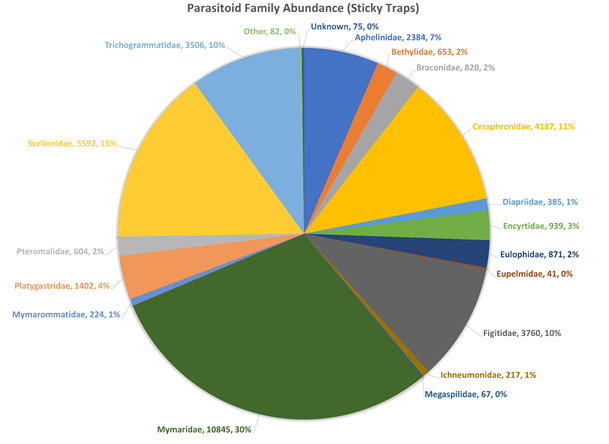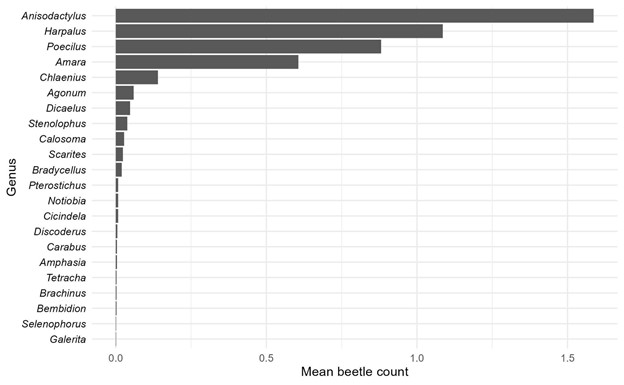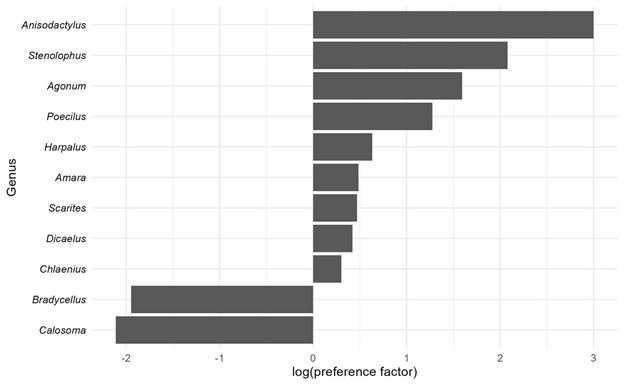Final report for LNE20-408R
Project Information
1) Problem, Novel Approach and Justification.
Agricultural drainage ditches serve a necessary function for water management on all farms. Especially for the flat Delmarva Peninsula (coastal plain portions of Delaware, Maryland, and Virginia) and portions of New Jersey, ditches are necessary to drain the high water table during the year. In addition, ditch habitats may also provide valuable ecosystem services to producers by enhancing natural enemies of pests and increasing their biocontrol. More broadly, ditches serve as examples of how uncultivated land in and around fields can provide ecological benefits. The goal of this proposal was to determine how to manage ditches to enhance populations of natural enemies, and to work with farmers to test management methods on farms.
2) Hypothesis and Research Plan.
The hypotheses were that ditches can be managed to increase numbers of natural enemies and to increase their biocontrol of pests in adjacent fields. The objectives were designed to complement each other and were conducted over three years. For our first objective, we focused on testing specific management practices to help determine which practices applied to drainage ditches will enhance natural enemies. Experiments were conducted on both University farm ditches and ditches on cooperating farms. For our second objective, we tested management practices as a way to enhance natural enemy performance in ditches and adjacent crops. Experiments were conducted on University farms. At the whole farm scale, the final objective was conducted using two ditches on each of five farms, over three years of sampling, to determine if ditch management does indeed enhance natural enemies and suppress pest populations by biocontrol.
3) Outreach Plan.
Results from Objectives 1 and 2 were explained to farmers participating with Objective 3 to determine what practices they could use to enhance natural enemies. Additionally, a pamphlet detailing beneficial arthropods, pests controlled by them, and the habitats that favor beneficial arthropods is being produced and disseminated to farmers, extension personnel, and conservation groups. Project performance was highlighted at other in-season events, such as research field days. Our University of Maryland website described project summaries and photographs of ditch management methods and natural enemies.
4) Project Objective.
Our specific objectives were 1) to conduct experiments designed to enhance populations of natural enemies (e.g., spiders, predatory mites and beetles, and parasitoid wasps) in ditches by providing resources for shelter, food, and reproduction, 2) to compare natural enemy performance in ditch habitats and adjacent crop fields across a range of habitat conditions, and 3) to use ditches on farms to demonstrate the value of this enhancement of natural enemies for pest management.
Our objectives are 1) to conduct experiments designed to enhance populations of natural enemies (e.g., spiders, predatory mites and beetles, and parasitoid wasps) in ditches by providing necessary resources for shelter, food, and reproduction, 2) to compare natural enemy performance in ditch habitats and adjacent crop fields across a range of habitat conditions, and 3) to use ditches on farms to demonstrate the value of this enhancement of natural enemies for pest management.
Agricultural fields are frequently disturbed, and natural enemies that serve as biological controls of pests must colonize the fields from elsewhere. Drainage ditches, because they are frequently left undisturbed, may be a source of natural enemies. Our long-term research was designed to determine what natural enemies are found in agricultural drainage ditches, and which ones move from ditches into fields during the production season. Specifically for this project, our research aimed to determine what ditch management practices aid natural enemies to reproduce in ditches and to disperse from ditches into crop fields. In this way, ditches may serve a valuable function of conservation biological control, whereby predators and parasites will suppress populations of arthropod pests.
An example of such a natural enemy from our research are jumping spiders, family Salticidae, in which certain species occurred in drainage ditches in the spring. As potential prey abundance decreased in the ditch during the summer, the spiders dispersed into neighboring crop fields to locate new types of prey. These predators followed a typical life history pattern of beneficial species: they reproduced in unmanaged areas and survive overwinter, then in late spring/summer they dispersed into crop fields and located injurious insect pests before reproducing in late summer and fall. We sought to encourage natural enemies to use ditches located within crop fields, and thus become a source of dispersing biological control agents into the adjacent fields.
Although our research funding began in spring, 2020, the pandemic stopped any potential research until June. As a consequence, we only performed preliminary research in 2020, and postponed most of our research to be conducted in 2021-2023.
The Lamp lab established a study on an agricultural drainage ditch at the University of Maryland Wye Research and Education Center as a randomized complete block design with four treatments and four blocks. Treatments included standard ditch management (mow in fall and no addition of straw), and and all combinations of spring mowing and fall straw additions. During the growing season, we used pitfall traps, sweep samples, and sticky card traps to identify species of natural enemies and the pattern of their occurrence. For example, from the pitfall traps, we identified lycosid and linyphiid spiders, ground and rove beetles, ants, crickets, and several families of parasitoid wasps. Over three years, we determined that the addition of straw as well as delaying ditch mowing to the spring enhances the overwintering survival of ground beetles in particular. Additional analyses of other groups of natural enemies is underway.
In another study, the Zebelo lab performed research to determine the movement of natural enemies from ditches to adjacent crops, and to measure predation rates of those natural enemies on insect pests. Measurements were taken in plots in which vegetation was cleared using chemicals while adjacent plots were left uncleared. Natural enemy abundance was higher adjacent to uncleared ditches, suggesting that they are a source of natural enemies such as parasitic wasps, spiny stink bugs, ladybird beetles, and pirate bugs. Using caterpillars as prey, they measured predation rates on cabbage adjacent to the ditch plots. They measured high predation rates, however no differences were found between cleared and uncleared plots.
Studies planned by the Owens lab included planting of various flowering plants, designed to attract natural enemies. In addition, a survey is being prepared for use during the winter meetings to determine how agricultural drainage ditches are managed.
Cooperators
- (Educator and Researcher)
- (Educator and Researcher)
Research
Our proposal has two hypotheses. First, we hypothesize that ditches can be managed to increase numbers of natural enemies by providing needed resources for shelter, food, and reproduction of beneficial species. Second, we hypothesize that ditches can be managed by planting flowering and non-flowering species to increase their biological suppression of pests in fields adjacent to ditches, thereby lowering pest populations and decreasing the need for insecticide applications.
1. Wye Study. To determine how ditches can be managed to enhance the number of natural enemies in ditches, the Lamp Lab began an experiment on an agricultural drainage ditch at the University of Maryland Wye Research and Education Center. Sixteen plots were created, set up in four blocks of four plots, and each plot was assigned a treatment. No treatment was applied during the summer, 2020, so the sampling of natural enemies was conducted to identify species and their abundance before any treatment was started. One treatment practice was started in fall, 2020: the addition of straw to the sides of the ditch. A second treatment practice of spring mowing was started in spring, 2021. Overall, four treatments were applied to the plots: 1) no change from normal practice of fall mowing and no straw added, 2) fall mowing and the addition of straw to ditch sides, 3) spring mowing and no addition of straw, and 4) fall addition of straw and spring mowing. Sampling consists of pitfall traps, sweep samples, and sticky card samples. We hypothesized that the addition of straw and spring mowing, either alone or in combination, enhanced the numbers of natural enemies compared to the control plots. The treatment practices were repeated in fall, 2021, and spring, 2022. Arthropod sampling was completed in 2020 (no treatment effect), 2021 (after practices applied over fall-spring, 2020-2021), and 2022 (after practices applied over fall-spring, 2021-2022).
The above photo shows a drainage ditch at Wye Research and Education Center in the process of spreading straw during fall 2021, effectively illustrating three of the four treatments. The nearest plot has been mowed for the fall, while the plot towards the back will not be mowed until spring 2022. The nearer ditch bank on the left has had straw spread over it, while the bank on the right had not yet been covered with straw.
2. Objective 3 Study. In 2021, the Lamp Lab set up farmer-assisted research on five farms. We identified two sections of ditches that were adjacent to the same crop field. The two sections did not differ in 2021, but over the winter, 2021-22, one of the ditches was mowed as usual in the fall, whereas the other section was left unmowed or partially mowed to help conserve natural enemies. Within each section, we established three transects including a sampling location in the ditch, 5 ft into the crop (corn or soybeans), and 30 ft into the crop. At each sampling location, we collected natural enemies by three trapping methods: sweep net, sticky trap, and pitfall trap. We sampled all farms for each month of the summer (June, July, August). These data will be used to compare the overwintering practice tested on each farm. Thus, arthropods were sampled during the summers of 2021 (before any difference in ditch pairs), 2022, and 2023. In practice, only two of the five farms did any differential handling of the ditches. We discovered that farmers felt strongly that ditches should be mowed cleanly in the fall after crop harvest.
3. Delaware Study.
In DE, to compare various treatments of land adjacent to ditches to enhance natural enemies at four locations, 50-ft plots were arranged in a randomized complete block design with four treatments and four replicates along the length of the ditch. Plots were installed at the Carvel REC in Georgetown, DE, the Daisey farm in Gumboro, DE, the Emerson farm in Middletown, DE, and the UMES research farm in Princess Anne, MD. At the Carvel REC, plots were 12-ft wide and installed on the NW side of a tax ditch. Replicates were separated by a 50’ft buffer. Wheat and soybean were planted adjacent to the plots. At the Gumboro location, plots were 5-ft wide but installed on each side of a field drainage ditch for a total plot width of 10-ft. Corn was planted on each side of the ditch. At the Princess Anne site, plots were 10-ft wide but also installed on each side of a field drainage ditch for a total plot width of 20-ft. A 5-ft buffer separated each plot. At the Middletown site, plots were installed into a large grassy swale cutting through a corn field. Plots were 20-ft wide and separated from each other by 5-ft.
In 2021, the following treatments were installed: wildflower planting, buckwheat planting, straw mulching, and an untreated area. Wildflower, buckwheat, and mulch plots were prepared by trimming existing vegetation and residue. Straw mulch was added in a 2-in layer. One standard sized bale covered approximately 200 sq ft. Wildflower and buckwheat plots were treated with glyphosate (Makaze, 5 qts/acre) with a CO2-pressurized backpack sprayer fitted to a 9-ft boom equipped with 6 8003 nozzles and calibrated to deliver 18 GPA at 26 PSI. Plots were treated twice prior to residue incorporation via Mantis tiller to prepare the seed bed. Wildflower seed (see table for species composition) was broadcast using a hand spinner at a rate of 9.7lbs /acre. Buckwheat seed was spread using the same method, this time at a rate of 50lbs /acre. After seeding was completed, the soil was raked to incorporate the seed. The Carvel REC Georgetown and the Gumboro site were seeded on 7 May. The Princess Anne MD site was seeded on 12 May and the Middletown site was seeded 14 May.
In 2022, the same plots were reseeded with the exception of the straw mulch treatment, which was not installed in 2022. Existing vegetation was treated with Rodeo (glyphosate) at a rate of 3 quarts per acre due to high winter annual weed competition and poor wildflower establishment. The soil at the Georgetown site was cultivated using an International Harvester tractor. The Middletown site was prepared using a walk-behind cultivator, the Gumboro site with a Mantis tiller, and the UMES site with a BCS walk-behind tractor. Buckwheat was seeded at 50 lbs/acre and wildflower seeded at 10 lbs/acre using a hand seeder. Soil was raked to incorporate seed. Wildflower (Native Northeast Seed Mix, American Meadows) and buckwheat plots were treated with Intensity One (12 fl oz/acre) for grass control when necessary. Georgetown was seeded on 6 May and treated for grasses on 9 June. Gumboro was seeded on 10 May and grasses treated on 9 June. Middletown was seeded on 21 May and grasses treated on 8 June. Princess Anne was seeded on 16 May and grasses treated on 9 June. Pitfall traps and sticky cards were deployed on 16 June and regular sampling began on 29-30 June and were conducted every two weeks until the end of August.
In 2023, only the UMES Princess Anne and the Middletown site were prepared and sampled. Wildflower plots were not treated with glyphosate but rather cultivated using a walk-behind cultivator and seeded with the American Meadows Native Northeast Wildflower Mix. Buckwheat plots were seeded at 50 lbs/acre. Plots were seeded March 31 in Middletown and early April in Princess Anne.
Sampling at all locations and years was initiated approximately 1 month after seeding. Each plot was sampled using three methods: yellow sticky card traps, pitfall traps, and sweep nets. Two sticky cards (3-in x 5-in) were placed in each plot (opposite sides of ditches in locations where both sides are used) approximately at the height of the existing vegetation. These cards are placed 5-ft from each end of the plot. A pitfall trap, consisting of two 16 fl oz solo cups nested in each other, was installed in each plot and partially filled with a propylene glycol solution (RV Antifreeze). A rain cover (1-sqft) covered each pitfall trap but provided a couple inches of clearance so as to not inhibit arthropod movement. Plots were also sampled with a 15-in diameter sweep net (10 sweeps per plot) at each sample date. The adjacent crop was sampled using pitfall traps approximately 25-ft into the field from the center of each plot, and 10 row-ft were visually assessed for insect pest presence and injury (when the crop was corn, only visual inspections were performed) at the edge of each plot and 25-ft interior. Sweep samples were only conducted when the adjacent crop was soybean (Princess Anne 2022, Middletown 2023, Georgetown 2021). Samples were placed in paper and Ziploc bags and placed into a freezer for storage until samples could be processed. Pitfall trap contents were placed in 70% ethanol-filled vials for storage.
4. UMES Study. To compare natural enemy performance in ditch habitats and adjacent crop fields across a range of habitat conditions, in the summer of 2021, two agricultural drainage ditches were selected in the Delmarva region in Bowman road (Location-1) and Stewart Neck road (Location-2), Princess Anne, Maryland. In ditch in location-1 was between cornfields, and the ditch in location-2 was between two soybean fields. Within each location, there were uncleared ditches and cleared. In location-1, the cleared and uncleared ditches had three 6 ft apart raised beds where the Brassica was grown at 1.5ft spacing (Figure 1 A). At Location-2, potted Brassica plants lined the ditch. Only in location-2 in both cleared and uncleared ditches had Brassica plants positioned 0 ft, 100 ft, and 200 ft from the ditch. In each bed or between potted plants, three 10-inch yellow sticky traps were mounted. Every week, traps were removed, and the number of beneficial insects was counted and replaced. Pitfall traps were also used to trap bugs in and around ditches. Each cup received 200ml of diluted propylene glycol solution. Three cups per plot were emptied, counted, identified, and replenished weekly. The results were compared using a paired T-test between cleared and uncleared ditches.
In the summer of 2022, a similar experiment was conducted in different ditch locations and designated as location-3 and location-4. However, we hadn’t cleared, and uncleared ditches with Brassica plants positioned 0 ft, 100 ft, and 200 ft from the ditch. Both these locations were between soybean fields. The methods and data collection used in 2022 was similar to the 2021 methods and data sets.
Evaluating the activity of natural enemies: Predation rates provided by ditch resident predators were quantified using corn earworm (Helicoverpa zea) and cabbage looper (Trichoplusia ni) larvae as sentinel prey. For estimating larval predation, ten third-instars were placed on the upper leaves of four randomly selected plants per plot. After 24 h of exposure in the field, the remaining larvae were counted to determine the number of larvae consumed by predators. Moreover, the sentinel larvae were reared for parasitoid emergence. To distinguish sentinel prey predation from unknown losses due to handling and rainfall, we enclosed one plant per site in a cage that excluded natural enemies. Plants in these cages were infested with ten sentinel prey and field-collected predatory wasp, Polistes spp. Net mortality due to predation was determined by assessing mortality from uncaged plants and subtracting it from mortality from caged plants. The experiment was repeated three times per plot, as described in [2].
In the summer of 2022, a similar experiment was conducted in different ditch locations and designated as location-3 and location-4. Both these locations were between soybean fields. However, unlike in 2021, in 2022, we focused on corn earworms (Helicoverpa zea) due to the unavailability of cabbage looper (Trichoplusia ni).
Wye Study.
We observed a diverse community of ground beetles within the drainage ditch at the Wye Research and Education Center, with common genera including Amara, Anisodactylus, Bembidion, Chlaenius, Dicaelus, Harpalus, Poecilus, and Pterostichus. Amara and Harpalus made up the vast majority of primarily weed seed-eating ground beetles, while the rest of these taxa made up the majority of primarily predatory ground beetles found in the ditch. In addition, the presence of ground beetle larvae indicate the use of drainage ditches for reproduction by ground beetles.
Results from the directional pitfall traps did not show any significant preference for the movement of ground beetles in either direction throughout the summer, but did demonstrate overall movement of ground beetles across the boundary coinciding with peaks in ground beetle activity-density observed through pitfall trap captures, indicating that ground beetles in the ditch are likely venturing into the field, and enhanced ground beetle density in the ditch may therefore correlate with greater numbers of ground beetles in crop fields.
We found no significant differences between mowing or straw treatments in 2021. In 2022, ground beetle activity-density was 97% greater in plots that had been covered in a layer of straw in fall 2021 than in plots in which no straw had been spread. Mowing treatments continued to show no significant differences in 2022.
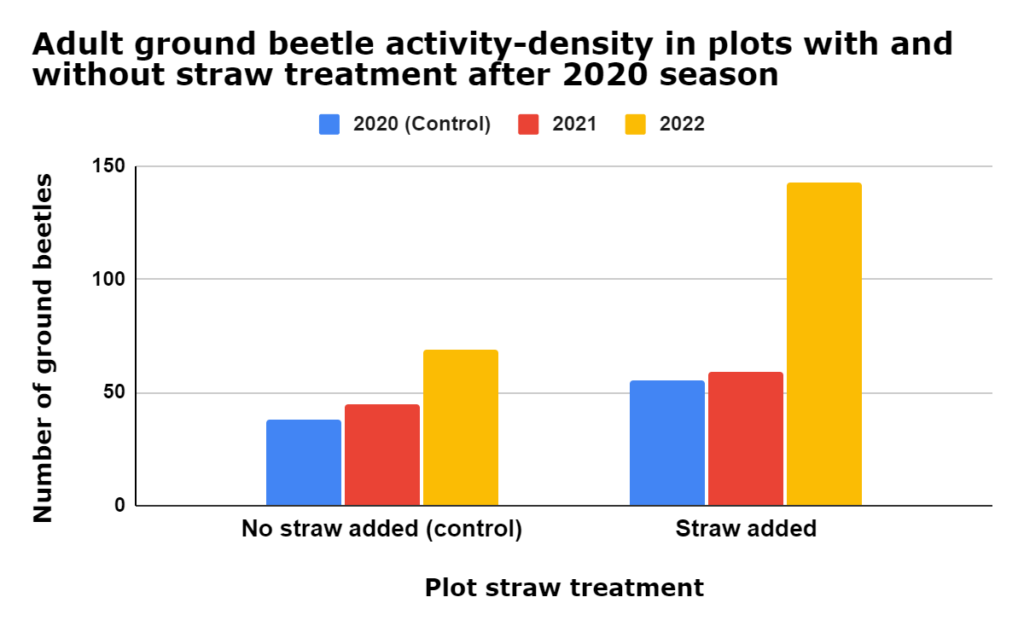
Average number of ground beetles captured in 2022 across each treatment.
Results of this study can be used to provide farmers with an additional tool to increase the activity of natural enemies and reduce damage caused by pests.
2. Objective 3 Study. Thus far, the Lamp lab has completed processing arthropod samples from 2021 and 2022. Sweep samples from 2023 are continuing to be processed so data is not yet available. Within sweep samples to date, we have found 9 orders of predatory invertebrates including 12 families within Araneae, and 23 families of parasitoid wasps. Most, if not all families collected have been found within all three habitats (ditches, borders, and fields) however, there is a significant difference in the abundance of most families within the ditches compared to the field and border habitats throughout June, July, and August.
In sweep samples, Dolichopodidae, Formicidae, Pteromalidae, and Scelionidae all follow the general pattern of higher abundance in ditch environments throughout the three months sampled. However, Anthocoridae, Linyphiidae, and Chrysopidae present unique patterns. In June, anthocorids are most abundant in ditch habitats, followed by a decrease in abundance through July and August. In border and field habitats, anthocorid’s abundance increased through July and August. Linyphiids are extremely abundant in ditches in June followed by a marked decrease to similar numbers compared to border and field habitats throughout the later months. The abundance of Coccinellidae throughout each habitat and month remained constant with between 1-3 individuals per trap. Chrysopids were not overly abundant but were present in ditch habitats in all three months and only present in July and August in border and field habitats. These families represent some of the most numerous groups within each order and patterns can be drawn from the 52 other predatory invertebrate families that have been sampled thus far.
In sticky traps, 36,654 specimens from 28 parasitoid families were identified. Overall, Mymaridae was the most abundant parasitoid family, followed by Scelionidae, Ceraphronidae, Figitidae, Trichogrammatidae, Aphelinidae, and Platygastridae. The most abundant non-hymenopteran families of natural enemies include Anthocoridae and Coccinellidae. Peak abundances of parasitoids were observed in August while the lowest counts were observed in July. There was no evidence of an interaction between month and sampling location in terms of overall abundance. The average Shannon diversity of parasitoids was highest in the month of June and lowest in the month of August. The average abundance of parasitoids was greater in samples taken from the ditch vegetation than either of the locations within the crop, and there was no difference in abundance between samples taken from 5 feet or 30 feet into the crop. However, diversity was found to increase relative to samples’ proximity to the ditch: samples from the ditch had greater diversity than those taken from 5 feet away, which had greater diversity than those taken from 30 feet away.
Abundance of each parasitoid family found on sticky traps over the course of the study.
Ceraphronidae, Eulophidae, Figitidae, Platygastridae, and Trichogrammatidae were all generally more abundant in ditch vegetation than crop vegetation regardless of distance into the the crop, while Aphelinidae, Braconidae, and Mymaridae did not vary in abundance by sample location. Scelionidae was more abundant in the crop closer to the ditch compared to the crop further from the ditch and most abundant in samples taken from the ditch itself. Populations of Aphelinidae and Figitidae were most abundant in June, while Mymaridae and Trichogrammatidae were most abundant in August. Other parasitoid families did not vary in abundance between months. Mymaridae and Trichogrammatidae were the only two families where the abundances were dependent upon interactions between month and sampling location. Trichogrammatids were more abundant in the ditch vegetation during the month of August while the abundances within the crop remained similar across the months. Mymarids were found to be more abundant in the crop and the ditch during the month of August, despite otherwise having no differences in abundance between the three locations.
The overall lack of abundance in July relative to other months may reflect the life cycle of parasitoids wherein that time is spent as larvae developing inside hosts. This could explain the drop in braconid abundance during that period. However, it more likely reflects population peaks of parasitoids from highly abundant families, namely Aphelinidae and Mymaridae, in June and August respectively. Families for which fluctuations in abundance were not observed are likely to have a seasonal life cycle that begins before or after the sampling period for this study, and may experience population peaks outside of the sampled months. For families with greater abundance in the ditch, a preference for hosts found in agricultural ditches over crop pests, an abundance of hosts in ditches, or the presence of nectar resources are possible causes for their distribution. Of those families, Scelionidae’s comparatively greater abundance in samples closer to the ditch may reflect either regular movement between the ditch and crops or hosts that prefer the edges of crops. Greater parasitoid diversity in ditches is explained by increased biodiversity with which they interact — a crop monoculture will primarily promote species trophically connected to it, while ditches contain a much more diverse array of plant species that support a more diverse array of herbivores, which in turn results in a more diverse array of parasitoids. Greater diversity in the crop sampling locations closer to the ditch may indicate travel between ditch and crop habitat, as adults emerge and seek new hosts or travel to the ditch in search of nectar. The decrease in diversity throughout the year can be attributed to specialist parasitoids finding their niche and a location where they can continue their life cycles. These results indicate that these uncropped habitats can foster natural enemy communities to better provide biological control.
Ground beetle study
The ground beetles collected from pitfall traps over the course of the study comprised 3,506 individuals and 23 genera. Generalist ground beetles which are known to feed on weed seeds as well as other arthropods were among the most abundant, including genera such as Anisodactylus, Harpalus, Poecilus, and Amara. Following those were more predaceous genera including Chlaenius, Agonum, and Dicaelus.
Average adult ground beetle counts from pitfall traps placed in agricultural drainage ditches and adjacent crop fields throughout the study.
Larval ground beetles were also captured from ditches and adjacent fields, although at much lower rates due to their limited mobility. They were observed most frequently in June and September, with the number of larvae in the ditch generally appearing to decrease over the course of the season. Common genera included Calosoma, Anisodactylus, Stenolophus, and Chlaenius.
Preference calculated for common ground beetles, showing that most genera were more likely to be found in drainage ditches than in adjacent cropland.
Preference factors calculated for the most common ground beetle groups showed that most genera were more likely to be found in drainage ditches than in adjacent cropland. This pattern was strongest for Anisodactylus, Stenolophus, and Agonum. However, Bradycellus and Calosoma were much more commonly found in the field rather than in the ditch. Habitat management practices are likely to be most effective in increasing conservation biological control by groups that are common in both drainage ditches and adjacent fields, i.e. with preference factors closer to zero, as they have the potential to be positively affected by altered drainage ditch management and move into adjacent fields to feed on plant and invertebrate pests.
Statistical analyses comparing ground beetle abundances between the ditch and adjacent fields revealed that these densities are correlated for most but not all genera. Anisodactylus, Poecilus, and Amara were significantly more likely to be found in the field at transects where they were present in greater numbers in the ditch, indicating that there is movement and spillover between these habitats. Thus, field populations of these genera may be more likely to be impacted by ditch management practices. However, Harpalus numbers were not correlated between the two habitats, and ditch abundances of Chlaenius and Agonum were only correlated with abundances in the third row (30 ft into the crop) and second row (5 ft into the crop) respectively. This implies a lower level of connection between populations of these groups, indicating that altered management of the drainage ditch may not have a strong effect on their densities in crop fields. The variation between groups highlights the importance of targeting research and conservation biological control efforts towards the specific groups for which they may be most effective at reducing pest populations.
3. Delaware Study.
2021 Observations. Buckwheat growth and abundance was much higher than wildflower growth and abundance. A dry period following seeding hindered wildflower germination. Preliminary observations indicated that during the first year, sweep samples from buckwheat plots seemed to contain the greatest number and diversity of beneficial insects. Extremely high grass weed pressure was observed in all plots, and perennial weeds were an issue in Georgetown. Some pitfall trap samples were lost due to wild animals and farm equipment. For sweep samples, buckwheat seemed to hold a greater number and diversity of beneficial insects. Weed and grass control is an issue that needs to be remedied in 2022. Other issues included loss of samples and supplies (mainly pitfall) resulting from wild animals and farm equipment. Grasses germinated from the straw mulch and the resulting plots were heavily vegetated with grasses. Milkweed and dogbane at the Middletown site were much more prevalent in the buckwheat and wildflower plots which were treated with glyphosate and clethodim for grass control.
2022 Observations. Plots at the Gumboro site were damaged by herbicide application from the adjacent corn mid-season. Grass weeds continued to be a major issue despite two applications of Intensity One (clethodim). Perennial weeds at the Middletown site competed with the sown wildflower seed. Perennials consisted mostly of grasses, dock, dogbane, and milkweed (the dogbane and milkweed also flower and serve in the same niche as the wildflower). Milkweed and dogbane were more prevalent in buckwheat and wildflower plots in Middletown in 2022. Mowing at the Middletown site was delayed from late July when the farmer wanted to mow until October. Wildflowers established at the Gumboro site, with some carryover from the previous year.
2023 Observations. In Middletown, grasses, thistles, morning glory, and smartweed competed strongly with seedings. At Princess Anne, grasses, ragweed, and a variety of perennial weeds competed with plots. Late thistle and morning glory weeds competed strongly with plots. Monarda, coreopsis, heliopsis, blanketflower, and black eyed susan were the primary established wildflowers. Heavy rains washed heavy field residue onto Middletown plots at the end of April. Generally, more wildflowers were observed in 2023 than in previous years.
Pitfall trap samples have been processed but not yet analyzed. Sweep samples from 2022 and 2023 are still being processed.
Buckwheat generally established well and flowered profusely attracting nectar seeking insects. Some stink bugs were observed feeding on buckwheat. It is possible that stink bugs may have been drawn out of the adjacent crop into the buckwheat. Buckwheat senesced early, during mid-summer. It may be a good component of a ditch seed mixture, but not as a sole treatment.
4. UMES Study.
From samples from ditches, to date, we have identified 47 families of arthropod natural enemies. A large number of the families are common in ditches, and also can be found in the adjacent crops.
The photo above shows parasitoids recovered from corn earworm larvae collected from field (18 families of hymenopteran parasitoids have been recorded from ditches in 2021) (A). Polistes spp predator prying on cabbage looper and corn earworm larvae (B).
The number of beneficial insects trapped with sticky traps was higher in uncleared ditches than the cleared ones in almost all locations in 2021 and 2022. The beneficial insects include soldier beetle, stinky bugs, lacewing, ladybird beetles, different types of bees, and unidentified wasps. The sticky and pitfall traps revealed that the abundance of insects is higher in uncleared ditches when compared with the cleared ditches.
In the preliminary trial in location-2, the abundances of insects decrease as the distance increased from the cleared and uncleared ditches. However, more insects were recorded in uncleared ditches in all distance points.
The number of prayed larvae was higher in the uncleared ditches in all locations, except the cabbage lopper larvae were prayed higher in the cleared ditches. Interestingly, in the summer of 2021, corn earworm larvae recovered from the larval predation trial in location-1 were parasitized by braconid wasp, Microplitis croceipes, and 41 wasps emerged from the corn earworm larvae collected from the cabbage plants near the uncleared ditch. Similarly, in the summer of 2022, more parasitoids emerged from the corn earworm larvae collected from the uncleared ditches in locations 1 and 2. Moreover, the result observed in the predation corn earworm larvae in 2022 were consistent with what was reported in 2021. The number of larvae missing where higher in the uncleared ditches than in the cleared ones in both locations.
In summary, the presence of vegetation in uncleared ditches created a habitat and a food source for insects, resulting in a higher insect population level. The level of natural enemies was higher in uncleared plots when compared with the cleared plot. The vegetation in the uncleared plot includes narrow-leaved grasses, mainly the Eragrotis family, and the broad-leaved flowering plants include gold star flowers, queen Ann lace, datura…etc.). This vegetation might support the insect population. In addition, if the agricultural ditches were maintained well with flowering plants, they might enhance the population of beneficial arthropods (pollinators and natural enemies).
The following conclusions are based on the data we have collected to date. Because of the pandemic, our experiments were delayed, and we have had issues hiring trained personnel for the project. All samples are collected and a majority have been completely processed but others are yet to be complete. We plan several manuscripts to submit this year.
Our findings clearly demonstrate that agricultural drainage ditches harbor abundant numbers of natural enemies representing a wide range of taxa. Arthropod taxa, including many spiders and over 50 families of beneficial insects, occur commonly and abundantly on all the farms we studied (10 farms). We found evidence that at least some of these move into crops with the development of the crop canopy, including several species of jumping spiders (Salticidae) that were abundant in ditches at the beginning of the growing season and became abundant in the adjacent crop in July and August. The diversity of parasitic wasps was also high, and they are commonly key sources of mortality to aphids, caterpillars, and other plant-feeding insects.
One concern we had was the possibility of ditches as sources of pest insects in crops. Low pest pressure in adjacent fields (data still being analyzed, but no notable defoliation observed from soybean, stink bug pressure in corn did not appear to be affected by adjacent plots) suggests that wildflower installation is not going to significantly affect pest pressure in adjacent fields for the average corn or soybean field. Flowering plants did attract pollinators and thus likely contributed to pollinator health where pollinator resources would otherwise be poor. Pollinators do contribute slightly to increased soybean yield (Garibaldi et al. 2021).
Weed competition, particularly deep rooted perennials and grasses, may pose significant challenges for landowners. Wildflowers may take more than one year to establish, thus careful site selection and maintenance for the first two years will be very important. Sites most likely to benefit from wildflower plantings are those that are dominated by grasses. Various NRCS programs may help offset the cost of plot establishment. Producers would also need to be especially careful when applying herbicide applications to the crop so as to not damage the plots.
Our experiment at the Wye site demonstrated that the addition of straw enhanced at least some groups of natural enemies, notably ground beetles. Our attempts to get farmers to apply straw, or even to delay cutting of ditch vegetation until spring, failed because of the aesthetic appearance of ditches over the winter. While the cost of straw may be prohibitive, our evidence suggests that delaying cutting of ditch vegetation to spring could be a good way to enhance the abundance of natural enemies in ditches and even encourage them to leave the ditch in favor of crop habitat in the spring. Additional experiments are needed to test this approach.
In conclusion, agricultural drainage ditches are a source of beneficial biodiversity on farms, including natural enemies but also pollinators and decomposers. Management of ditches by planting wildflowers or timely mowing may enhance these beneficial insects, although injurious pests may also be able to utilize the habitat, say as an overwintering site. While ditches vary in size and water flow, it is not clear whether these or other conditions predict their value for beneficial species. We believe farmers should recognize that ditches are a source of beneficials, and thus protect them from adverse conditions for insects such as pesticide drift or untimely mowings.
Education & Outreach Activities and Participation Summary
Educational activities:
Participation Summary:
Zebelo s. Shelly-Ann H. 2022. Managing agricultural drainage ditches to improve conservation biological control. University of Maryland Eastern Shore Small Farm Conference. November 4, 2022, Princess Anne, MD
Zebelo S. 2023. Managing agricultural drainage ditches to improve conservation biological control. University of Maryland Eastern Shore Small Farm Conference. November 4, 2023, Princess Anne, MD. Attended by 34 farmers and educators.
Shelly-Ann H, Zebelo S. 2022. Managing agricultural drainage ditches to improve conservation biological control. 10th International IPM Symposium. February 28 – March 03, 2022, Denver, CO.
Shelly-Ann H, Zebelo S. 2021. Managing agricultural drainage ditches to improve conservation biological control. Entomology 2021. October 31 - November 3, 2021, Denver, CO.
Shokoohi, A. and W. Lamp. 2022. Enhancing biological control by ground beetles (Coleoptera: Carabidae) through agricultural drainage ditch management practices. Eastern Branch Entomological Society of America, April, 2022, Philadelphia, PA.
Shokoohi, A., and W. Lamp. 2022. Enhancing biological control by ground beetles (Coleoptera: Carabidae) through agricultural drainage ditch management practices. Entomological Society of America Joint Annual Meeting, Vancouver, Canada.
Shokoohi, A. & W. O. Lamp. 2023. Enhancing biological control by ground beetles (Coleoptera: Carabidae) through agricultural drainage ditch management practices. Entomological Society of America Eastern Branch Meeting. Providence, RI. Oral Presentation.
Shokoohi, A. & W. O. Lamp. 2023. Enhancing biological control by ground beetles through agricultural drainage ditch management practices. NCCC-31 Annual Committee Meeting. Blacksburg, VA. Oral Presentation.
Salerno, R., Shokoohi, A. & W. O. Lamp. 2023. Evaluating Ground Beetle (Coleoptera: Carabidae) Movement Between Agricultural Drainage Ditches and Arable Fields: A Case History for Conservation Biological Control. Entomological Society of America Eastern Branch, EntoQuest. Lewes, DE. Poster Presentation.
Shokoohi, A. & W. O. Lamp. 2023. Enhancing biological control by ground beetles (Coleoptera: Carabidae) through agricultural drainage ditch management practices. Entomological Society of America Eastern Branch. Lewes, DE. Poster Presentation.
Windsor, S., Shokoohi, A. & W. O. Lamp. 2023. Analyzing spatial and temporal distribution of hymenopteran parasitoids within agricultural drainage ditches and adjacent cropland. Entomological Society of America Annual Meeting. National Harbor, MD. Poster Presentation.
Shokoohi, A. & W. O. Lamp. 2023. “Enhancing biological control by ground beetles (Coleoptera: Carabidae) through agricultural drainage ditch management practices.” University of Maryland College of Agriculture and Natural Resources Cornerstone Event. College Park, MD. Poster Presentation.
(AGNR Cornerstone Event Poster Competition – Third Place)
Shokoohi, A. & W. O. Lamp. 2023. Enhancing biological control by ground beetles (Coleoptera: Carabidae) through agricultural drainage ditch management practices. Entomological Society of America Annual Meeting. National Harbor, MD. Oral Presentation.
Learning Outcomes
We informed our collaborating farmers about the types of insects we had collected in the ditches, and they were impressed with the diversity of form and function of the natural enemies that we encountered. We discussed our findings about the role of straw and vegetation growth in enhancing the winter survival of these beneficial insects, but they felt that not mowing their ditches is against the normal operation of farms and would affect the aesthetics of their farm. Unable to change the practice of fall mowing, we decided that we need to increase our education of farmers about the value of insect biodiversity associated with ditches, and therefore plan to produce a color trifold that describes the various beneficial ecosystem services provided by insect species found in ditches. The trifold will suggest that delaying mowing or addition of vegetational debris, like straw, can help insects survive winters. We intend to get wide approval of this publication by soliciting reviews from our advisory board and other stakeholders.
Project Outcomes
Our results indicate that high plant biodiversity in uncleared drainage ditches near agricultural fields is related to high natural enemy populations. We generated data to further study the needs of specific biological control agents in drainage ditches by applying larger grants to incorporate other disciplines in a more holistic proposal. Potential specific programs for future research and extesnion efforts include USDA-NIFA's Foundational Program, Organic Transitions (ORG) programs, NSF's Long Term Research in Environmental Biology (LTREB), and Coupled Human and Natural Systems (CNH) programs. We conclude that increased awareness of growers to conserve natural enemies in agricultural drainage ditches is of value, thus we are developing extension information to help with this awareness.
